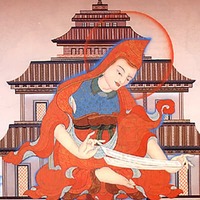
Shantideva
Shantideva was born in the eighth century as the son of the king of a land in the Bengal region of East India. When he was about to ascend to the throne, he had a dream of Manjushri, who said, “The throne is not for you.” Heeding Manjushri’s advice, he renounced the throne and retreated to the jungle. There he met and studied with various non-Buddhist gurus, meditated intensely and achieved advanced states of absorbed concentration. But, as was the case with Shakyamuni, he realized that withdrawing into deep states of concentration did not eliminate the roots of suffering. Relying on Manjushri, he eventually had actual visions of this embodiment of the wisdom of all the Buddhas and received teachings from him.
Shantideva then left the jungle and went to the monastic university Nalanda, where he was ordained as a monk by the abbot. There, he studied the great sutras and tantras and practiced them intensely, but he hid all his practices. Everyone thought he did nothing but eat, sleep, and go to the toilet. But, in fact, he was always in a clear light meditative state.
Finally, the monks of the monastery decided to expel him, as they thought he was useless. As a pretext, they told him he must give a discourse on an original text, thinking he would make a fool of himself. They set up a very high throne without any stairs, thinking he could not reach it. But the throne descended to the level of Shantideva, so that he could easily ascend it.
Then he began the teaching of Engaging in Bodhisattva Behavior, Bodhicharyavatara. When he reached a certain verse in the ninth chapter on voidness (emptiness), he slowly rose in the sky. The verse was:
(IX.34) When a (truly existent) functional phenomenon or a (truly existent) nonfunctional one (its voidness) do not remain before the dualistic mind, then since the other alternatives cannot be the case, there’s full pacification into (a state) without mental aim (at the impossible).
After that, only his voice was heard, reciting the rest of the text. He himself had disappeared from sight. The monks later wrote down the text from memory.
In his teaching, Shantideva referred to two other texts he had written at Nalanda: (1) The Compendium of Trainings, Shikshasamuccaya and (2) The Compendium of Sutras, Sutrasamuccaya, but no one knew where they were to be found. Someone finally had a vision of Shantideva telling him they were hidden in the beams of the ceiling of a certain monk’s room. Shantideva said in the vision he would not return himself.
The Compendium of Sutras summarizes the main points of the sutras, while The Compendium of Trainings summarizes the sutra practices. The Tibetan translation of the second text, as well as of Engaging in Bodhisattva Behavior, is found in the Tengyur, the collection of Tibetan translations of the Indian commentaries to Buddha’s words. According to Khunu Lama Rinpoche, The Compendium of Sutras was translated into Tibetan, but it is not to be found in the Tengyur.
There were several commentaries written to Engaging in Bodhisattva Behavior, especially to the ninth chapter. The Tibetan ones come from all traditions, as this text is central to all schools of Buddhism in Tibet. In the Gelug tradition, Tsongkhapa’s Grand Presentation of the Graded Stages of the Path (Lam-rim chen-mo) relies very much on The Compendium of Trainings and Engaging in Bodhisattva Behavior, especially for the teachings on the exchange of self and others. Although Tsongkhapa did not write a separate commentary to Engaging in Bodhisattva Behavior, his Grand Presentation of the Graded Stages of the Path covers many points treated in it. His Essence of Excellent Explanation of Interpretable and Definitive Meanings (Drang-nges legs-bshad-snying-po) covers many points from chapter nine. His Illuminating the Intent: An Explanation of (Chandrakirti’s) “Engaging in the Middle Way” (dBu-ma dgongs-pa rab-gsal) also relies strongly on it.
-
Engaging in Bodhisattva Behavior “Engaging in Bodhisattva Behavior” (Skt. Bodhisattvacharyavatara) has ten chapters dedicated to the development of bodhichitta through the six far-reaching attitudes (perfections) – generosity, ethical self-discipline, patience, perseverance, concentration and discriminating awareness (wisdom).
-
Part 1The Benefits of Bodhichitta
-
Part 2Openly Admitting Previous Negative Acts
-
Part 3Gaining Hold of a Bodhichitta Aim
-
Part 4Taking Care about Bodhichitta
-
Part 5Safeguarding with Alertness
-
Part 6Showing Patience
-
Part 7Perseverance
-
Part 8Perfection of Concentration
-
Part 9Perfection of Wisdom
-
Part 10Dedication
-
Part 11Note to the Translation
-